TOPIC 6
PHOTOGRAPH READING AND INTERPRETATION
Definitions of Photograph
- Photograph is picture produced by using a camera or satellite or radar, and then made visible and permanent by chemical treatment, or stored digitally.
- Photograph is a picture taken by means of chemical lights prepared on a special paper.
- Photograph is a picture made using a camera, in which an image is focused on to light-sensitive material and then made visible and permanent by chemical treatment, or stored digitally.
- Photograph is an image of a person, object, or view that is produced by using a camera and film
- Photograph is a picture obtained by using a camera and film that is sensitive to light
- Photograph is a representation of a person or scene in the form of a print or transparent slide; recorded by a camera on light-sensitive material
- Photograph is an image or a picture of an object which is recorded by a camera and then printed on a paper.
- Photograph is an image of an object which is recorded by a camera and then printed on paper.
Photograph interpretation is a process of reading, measuring and interpreting photographs for obtaining reliable information about natural or human features and their environment.
In other words, photograph interpretation can be defined as analysis and examination of photographs so as to be able to identify natural or artificial features.
A Photograph of Hills
Types of Photographs
1. Ground (Horizontal) Photographs
2. Oblique Photographs
3. Vertical Photographs
1. GROUND LEVEL PHOTOGRAPHS
These are the photographs taken on the level grounds when the optical camera axis is horizontal to the object. Or, these are photographs that are taken from the ground when the camera is at the same level as the object being photographed. Objects are large and clearly shown in these photographs when they are close than those far from the camera The fore ground and the horizon is seen but the back /dead ground is not seen There is no fixed scale. They are sometimes known as Terrestrial Photographs

Ground (Horizontal) Photographs
Characteristics of Ground Level Photographs
1. They show only the (front) side view of an object
2. It is taken when the camera is near the to the ground
3. Its scale decrease from the foreground to the background
4. They have the optical camera axis horizontal to an object
Uses of Ground Level Photographs
1. They are used for the identification of the objects because the features are shown clearly
2. They are for ordinary photographs
2. OBLIQUE PHOTOGRAPHS
These are the photographs taken from hills looking down with camera towards the ground. Sometimes they are taken from low flying planes, towers or from tall building. Or, are the photographs taken when a camera is slanting at an angle less than 90°. They are taken when the photographer is standing on an elevated ground and hold the camera on an angle towards the lower ground. They normally cover the horizon.
Types of Oblique Photographs
1. Low oblique Photographs
2. High Oblique Photographs
A) LOW OBLIQUE PHOTOGRAPHS
These are the photographs taken with camera tilted not to include the horizon the photograph. Or, these are taken when the photographer is standing in elevated ground, such as top of a hill, building or cliff, and holds the camera at an angle pointing towards the lower ground. The photograph can also be taken when the photographer is standing at the bottom of an elevated ground, with the camera pointing towards the higher ground.

Low oblique Photographs
Characteristics of Low Oblique Photographs
1. It covers a small area
2. It does not show the horizon
3. It shows the top and front views of the objects
4. They are taken from an elevated area at 45°(for example: from the top of the mountain)
5. The features in the fore and middle ground are shown clear
Uses of Low Photographs
i) They are used for the identification of the objects because the features are shown clearly
ii) They can be used for geographical research
B) HIGH OBLIQUE PHOTOGRAPH
These are photographs taken with the camera tilted to include the horizon. Or, these photographs are taken from the sky with the camera tilted at an angle towards the ground. The photographer may take the photograph from a helicopter or lowflying aeroplane. These photographs cover quite a large area of land.

High Oblique Photograph
Characteristics of High Oblique
1. They show large area
2. They are taken at 60°
3. They show the horizon
4. They show both the front and top view
5. They are important in map making
Oblique Photographs can be Low Oblique (if the horizon is not visible) or High Oblique (if the horizon is visible)
Low Oblique versus High Oblique Photographs
3. VERTICAL AERIAL PHOTOGRAPHS
These are photographs taken with camera whose axis tilted vertically to the ground at right angle (90°). These are photographs taken from the aircraft with the camera directly above the object pointing vertically to the ground. Only the top view is seen. Instruments used to capture pictures are called air crafts or the satellites


Vertical Photographs
Characteristics of Vertical Aerial Photographs
1. They show large areas
2. They are taken from the air
3. They are taken when the camera is placed vertically towards the object
4. They can be used in map making
5. They contain a lot of detailed information of a given photographic region since they print everything
Uses of Vertical Aerial Photographs
1. They are used for plotting contour lines
2. They are used for map making
3. They are used for military purposes
4. They can produce variety of scales like small scale and large scale
5. They are used for pilot studies before conducting field trip
6. They can be used for investigation or researches
7. They can be also used for rapid survey of unknown area like thick forests and high mountains
Differences between Oblique/Ground Photograph and Vertical Photograph
1. Vertical photographs show the top view while Oblique photographs show the top and front view
2. It is difficult to identify objects in Vertical photographs than in Oblique photographs
3. In Vertical photographs, all important features are seen while in Oblique photographs some important features are not seen.
4. Oblique photographs are less expensive than Vertical photographs
5. It is difficult to recognize the image of the Vertical photographs while the image or picture of Oblique photographs is easily recognized
6. It is easier to determine the scale in Vertical photographs than in Oblique photographs
Comparisons between Photographs and Maps
1. Both photographs and maps are important in learning geography
2. They both have scales
3. Both are used in military for techniques
4. Both show the physical and relief features on the earth
5. Both are used by planners when planning for something or a project
6. They both represent the three dimensional World on the flat surface
Differences between Maps and Photographs
MAPS
PHOTOGRAPHS
- They have keys
- They have not keys
- They are selective
- They are not selective as they print everything
- They have titles
- They do not have titles
- They are very expensive
- They are less expensive and fast
- They take much time in making a map
- They take less in producing a photo
- The scale is constant or uniform
- The scale is not constant or uniform
- They need skills to interpret them
- They are very easy to interpret
1. Photographs store information for future generation
2. They act as main house of information of a place
3. Photographs are used to prepare the topographical maps
4. They provide quick and instant information than maps
5. They replace verbal description and save time
6. They show real feature of the earth and provide a good visual impression for observation and interpretation
7. Photographs are also used in geographical research
PHOTOGRAPH READING AND INTERPRETATION
Is the process of reading, measuring, translating and explaining the meaning of objects identified on that photograph. It is done so as to obtain reliable information about the natural or cultural features on their environments. It involves the following;
1. Determining the title Estimating time and the season
2. Estimating direction Identifying and interpreting physical features Identifying and
3. Interpreting human activities
4. Estimating the size of features Suggesting possible location of the scenery in the place
Determining the Title
Can be obtained by carefully studying the photograph, information determines the choice of the title. Photos show landscapes, activities on land, what is on the surface and the sky. The information contained in the foreground, middle ground and dead ground can help in determining a suitable title
Estimating Time and Season
1. TIME
It is possible to estimate the time of day when the photo was taken if we know where the photograph was taken If the photo was taken during the morning its evidence is through the shadow
1. During the Morning: The shadow of the object lies in the western side because the sun rises from the east
2. During the Evening: The shadow lies in the eastern side because the sun sets on the west
3. During the Afternoon: The shadow lies around the object because the sun is over head of the object
2. SEASONS
1. A bright sky with dry vegetation may indicate a dry period or season.
2. Thick vegetation young crops or flowering plants in the field and a sky full of rain clouds indicate a rainy season
3. Clear sunny conditions with health vegetation and flowering plants or plants with fruits indicate summer season
4. Plants with young leaves others bloom and field full of grass indicates spring season
5. Hazy sky with leafless trees and some snow on the ground indicates winter season
6. Also when people appear to be wearing heavy clothes with faces almost completely covered, hand gloves and heavy boots it indicates cold weather, likely winter in temperate regions
7. People wear light clothes and some may even have broad-rimmed hats indicates hot weather
8. When houses appear to have slanting roofs it indicates the region experiencing a lot of precipitation which facilitates the easy flow of water from the roof of the house
9. If people appear to be planting then it is planting season the rains either are about to come or have just started
10. If the people appear to be weeding it is growing season for the crops and there is reduced rainfall
11. If people appear to be harvesting a crop it is harvesting season and probably dry season because harvesting normally takes place during dry weather.
12. If people appear to cultivate and plant various crops, it indicates rainy season because such process is normally done during rainy season so as the rain can support the plant growth.
13. If people appear to harvest the crops, it indicates dry season because harvesting is usually done during the dry season.
Estimating Direction
This refers to identifying the position of the photographer after studying the relative sizes of objects in the photograph. It is possible to estimate the direction on a photograph using shadows. This is possible if the time and place where the photograph was taken are known.
For example, if a photograph shows a tree whose shadow is on the right and it is indicated that it was taken within the tropics and in the morning, then the photographer was facing south. The sun and the shadow are always in the opposite sides of the photograph.
If the sun is in the east, the shadow will always be cast westwards and vice versa. If the shadow is pointing towards you and the photograph was taken in the afternoon (meaning that the sun was in the west), the photographer was facing westwards. With such information, it is then possible to fix compass points on a photograph.
The other alternative for identifying the position of the photographer or cameraman is by observing the size of objects in the photograph. The objects close to the photographer appear larger those far away. The objects apparently appear to decrease in size as their distance from the photographer increase. Therefore, the part of the photograph showing huge objects is the place close to where the photographer stood.
IDENTIFYING AND INTERPRETING PHYSICAL FEATURES
Many physical features shown in the photograph can be identified and interpreted. These features include relief, drainage, and vegetation, among others.
RELIEF
Before interpretation of other physical features, it is important to first identify relief features on the photograph. Start by giving a general idea about the area shown in the photograph. In describing landscape and landforms, it is important to go even further and describe the forces and processes that are responsible for their formation and modification. This is an essential aspect of relief interpretation. Relief features in the photograph may include the following features:
1. Ridge. Ridge is a narrow and long relief feature with steep slopes on all sides.
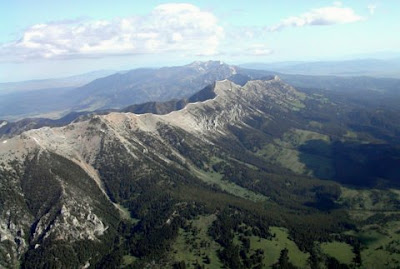
Ridge
2. Escarpment
An escarpment is an area of highland with very steep slopes on one side and a gentle slope on another side. The steep slope of an escarpment is called the scarp slope and the gentle slope is known as dip slope.
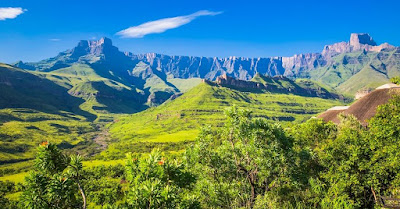
Escarpment
3. Plateau
A plateau is an extensive highland region and whose top surface is almost flat. A plateau is easily identified on the map by the absence of contour lines on the higher land surface and with a series of contours close together on either sides.
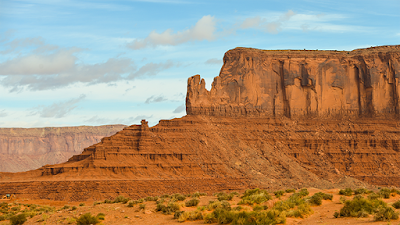
Plateau
4. Slopes
A slope the inclination or slant of the land. This inclination varies considerably, resulting in the following types of slopes A concave slope are widely spaced at the lower ground and closely spaced at the higher ground. A convex slope on the other hand has a steep slope at the lower ground and a gentle slope at the higher ground. Contours of this slope are closely spaced at the lower ground and widely spaced at the higher ground. However some slopes bear both characteristics, a concave slope is gentle at the lower ground and gets steeper at the higher ground.
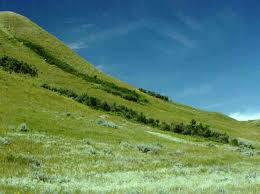
Slopes
5. Col. A Col is the land between two peaks of a mountain or in the mountain ranges.
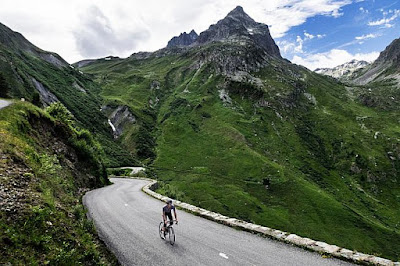
Col
6. Saddle (pass). A saddle is generally wider than a col. Saddles provide convenient passages across mountain ranges. Contours showing peaks are usually closed.
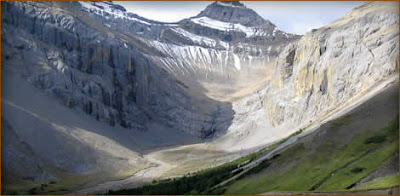
6. Valley. Valley is the low lying part of the land which is bound over higher ground and steep slope. Valleys are indicated by contours forming ‘V’ shape pointing the higher ground and some valleys have rivers flowing in them.

Valley
7. Spur. Spur (Salient) is a projection of the raised land from the side of a hill or mountain into lowland, contours showing a spur form a ‘V’ shape pointing to the lower ground.
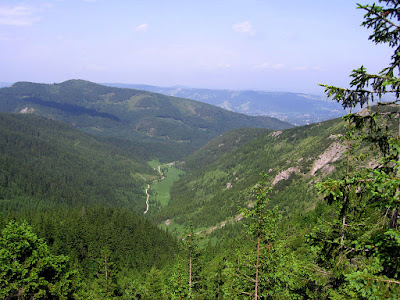
8. Hills/Peaks
A hill is a rounded upland area not as high as a mountain. Hills rises above the general relative low ground but less than a mountain. Hill height is usually about 350m-650m. Some hills are regular while others are irregular. A hilly landscape is shown on photographs as having varied relief of hills and valleys that are not isolated on a flat landscape. Where hills appear to have the same height across the entire landscape, such a landscape is probably a dissected plateau. Streams have cut valleys across former flat land and some interlocking spurs may be visible towards valleys.
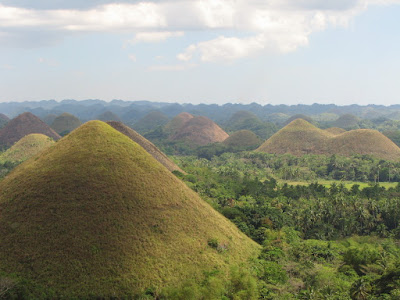
Hills
9. Cliff
A cliff is described as a steep rock face that is vertical or nearly vertical. Cliffs are common in mountainous or hilly areas and along the shores of lakes and seas. On topographical maps, cliffs are shown by contours that are so closely packed that they appear to merge into one another. To emphasize the presence of the cliff, a special symbol is drawn on top of the contours as shown in the figure below.
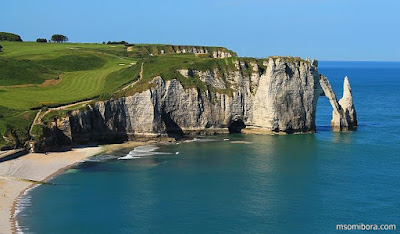
Cliff
10. Plain
A plain is a continuous tract of relatively flat land covering a broad area of lowland. Some plains may be raised but the slopes are very gentle. Plains occur as lowlands and at the bottoms of valleys but also on plateaus or uplands at high elevations. On topographical maps, a plain is shown by contours that are very widely spaced. Some rivers, if present, may be seen to have meanders.
Plains altitudes are less than 500 metres while plateau altitudes are more than 500 metres above sea level. It is impossible to tell the average area of the land directly from a photograph. However, other features appearing in the photograph, such as part of the sea, crops and other economic activities may be used in estimating the altitude.
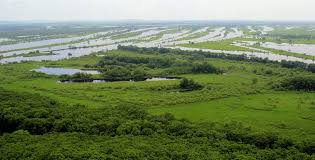
Plain
11. Depression.
A depression on a contour map is shown by contour lines with small marks pointing towards the lowest point of the depression. The first contour line with the depression marks and the contour line outside it have the same elevation.

Depression
12. Mountain. This refers to the upland or highland over 1000m from the mean sea level
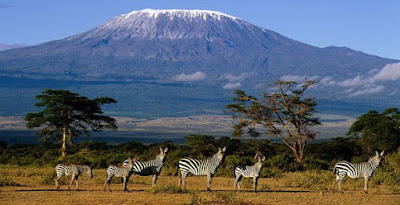
Mountain
DRAINAGE
Drainage features such as rivers, lakes and seas may easily be identified in all types of photographs. Different aspects of rivers can be studied on a photograph. These include the shapes of river valleys, stages of development and various features. Based on the presence of certain features, one can tell the nature of the rock over which the river flows. For example, the presence of rapids and waterfalls is an indication that the river is flowing over steep land.
River meanders are an indication that the river is in it mature or old-age stage. Interlocking spurs indicate that the river valley is made of alternating layers of hard and soft rocks. Drainage patterns are easier to identify on vertical aerial photographs. The colour tone of areas covering deep water appears darker than those of shallow water. The various functions of the river can also be identified.

River
VEGETATION
Photographs show all types of vegetation in the photographed area. Planted (artificial) and natural forests appear to be distributed unevenly, with planted forests usually in clear straight lines. In planted forests trees tend to be of the same type, size and height because they were planted at the same time. The plant characteristics that may appear on the photograph can be used as a guide to the general types of vegetation, for example savannah or semi-arid vegetation.
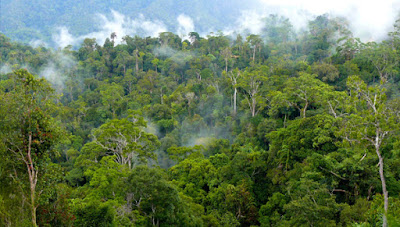
Natural Forest
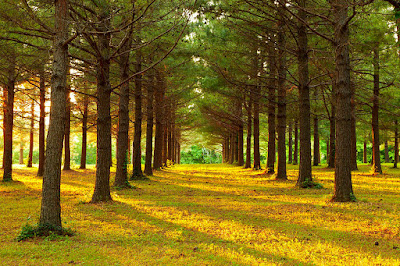
Planted or Artificial Forest
SOIL
A clue on the type of soil in a photographed area may be given by the types of crops grown and appearing on the photograph. For example:
1. Rice grows well in clay soil.
2. Tea and coffee require volcanic soil.
3. Coconuts and cashew nuts thrive well in coastal regions with sandy soils,
4. Variety of horticultural crops thrive in loam soils.

Clay Soil
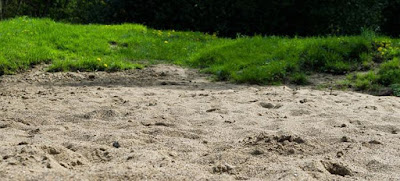
Sandy Soil
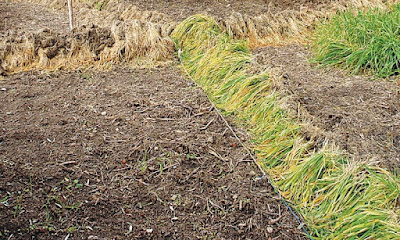
Proper interpretation of the soil requires an application of one’s general knowledge of geography learnt in classroom as well as knowledge from other disciplines.
CLIMATE
Weather and climate are not shown directly on photographs. Features contained in a photograph can be used to make conclusions about the climate of a photographed area. The type of crops grown and vegetation on the photograph can be used as a clue to establish the climate of a place. Vegetation types and crops can also provide evidence about the season or climate of a place. For example:
1. The presence of many cacti signifies an arid or semi-arid region, and hence a desert or semi-desert climate.
2. Crops such as sisal are grown in hot areas that receive low rainfall while sugarcane thrives in warm to hot climate with high rainfall.
3. The type of clothing people in the photograph are wearing can give an indication about the weather and possible climate.
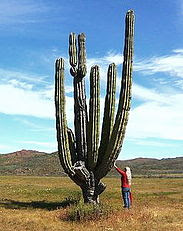
Cacti
IDENTIFYING AND INTERPRETING HUMAN ACTIVITIES
Human activities on a photograph are depicted by various forms of land use. The uses of land may in form of agriculture (crop cultivation and animal husbandry), forestry, settlement, wildlife conservation, mining and construction of infrastructures, among other uses.
1. AGRICULTURE
This includes crop cultivation and livestock rearing. It is practised at subsistence and commercial levels. It is easy to identify agricultural activities on ground photographs. To be able to identify these features on vertical aerial photographs, it requires close examination of the features. Some evidences that can be used to establish the kind of agricultural activities taking place in an area shown on the photograph are summarized as follows:
Type of Farming Evidences
a) Subsistence Crop Farming
- Some houses are permanent while others are temporary
- The land is often divided into small plots owned and cultivated by individual farmers
- Mixed farming is practiced
-Simple farming tools such as hoes, mattocks, pangas and rakes are used
- Fields are separated by hedges
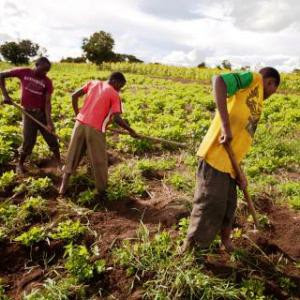
Subsistence Crop Farming
b) Subsistence Livestock Farming
- Indigenous and exotic animal breeds are kept
- Animals are grazed on grassland or semi-arid vegetation
- Large herds of local cattle (zebu), goats and sheep
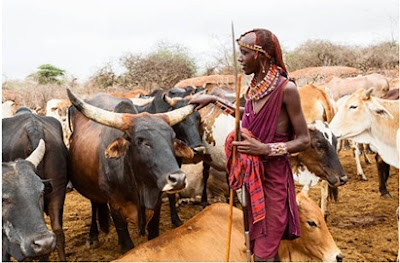
Subsistence Livestock Farming (Pastoralism)
c) Commercial Livestock Farming
- Large fields divided into paddocks
- Presence of cattle sheds near farm houses
- Windmills for water supply
- Presence of water tanks, ponds or reservoirs in the dry areas
- Evidence of livestock infrastructures such as cattle dips or spray races, abattoir, cattle bomas, slaughter slab, etc.
- High grade exotic or crossed cows with large udders
- Milking parlour with milking machines, and milk processing plants
- Indoor grazing units
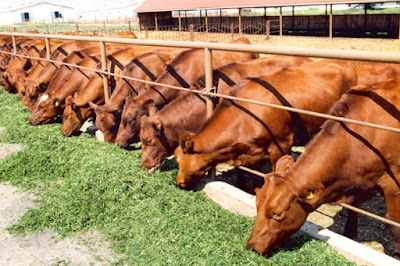
Commercial Livestock Farming
d) Commercial Crop Farming
- Presence of cash crops on an extensive area
- Evidence of modern farming methods, e.g. farm machinery
- Facilities for collecting crops, e.g. sheds and stores
- Presence of access or feeder roads within the farm
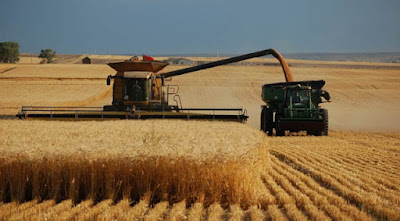
Commercial Crop Farming
e) Plantation Farming
- A single crop covering extensive stretches of land, e.g. sugarcane, tea, coffee, sisal, wheat
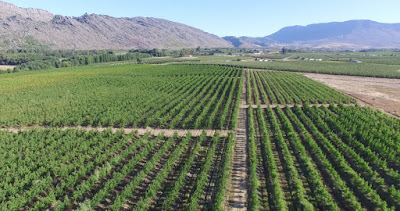
Plantation Agriculture
2. PROCESSING FACTORIES
- Presence of storage facilities, e.g. silos
- Many labourers in the fields
- Nucleated settlement within the farm. These are usually for the workers’ housing
- Presence of a network of roads crossing the farm to facilitate mechanization and haulage of inputs and produce to and from the farm, respectively

3. INDUSTRIAL AND MINING ACTIVITIES
The following evidence can be used as a guide in identifying industrial and mining activities on a photograph:
1. Presence of Factory, buildings with tall chimneys that might be issuing a lot of smoke
2. Nucleated settlements in the neighborhood, likely to be the laborers’ houses
3. Tall chimneys emitting flames and a network of pipes with large tanks in the distance could indicate an oil refinery
4. Large open pits, large excavators and lorries carrying loads of rocks could indicate open cast mining
5. A large area with derricks (oil rigs) could point to an oilfield where oil is mined
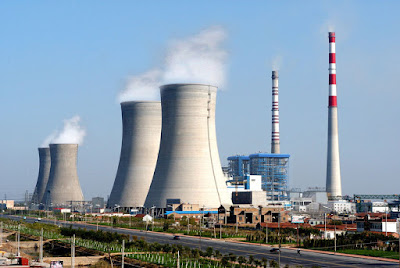
Industries (manufacturing)
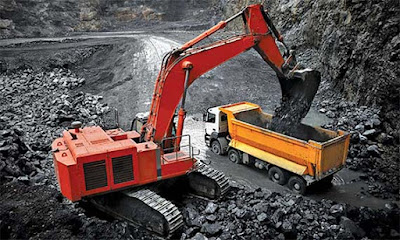
Mining
4. LUMBERING
Lumbering activities could be indicated by the presence of the following features/activities:
1. Logs floating down the river
2. People cutting trees using manual or power saws
3. Large forest clearings with tree stumps and piles of logs
4. People loading timber onto lorries or tractor trailers e. Logs piled near a saw mill
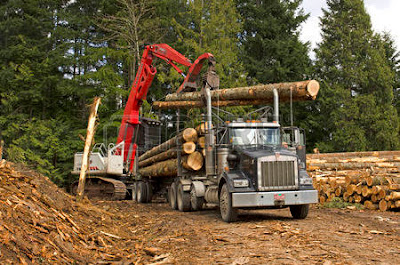
Lumbering
5. TRANSPORT AND COMMUNICATION
a) The clues or indicators on Transport.
1. Presence of motor vehicles and roads Animals carrying loads on their backs Presence of railway line Presence of ports, boats, ships or large water bodies.
b) The clues or indicators for Communication
This may be indicated by the presence of telephone lines, telephone booths, satellite dishes, buildings with masts and wires connecting the masts, post office, radio or television station, newspapers or newspaper stands, etc.

Transport and Communication
6. Tourism: look on the presence of; National parks, Game reserve Recreational centre’s e.g. museum, archives beaches etc Landscape e.g. crater depression etc.
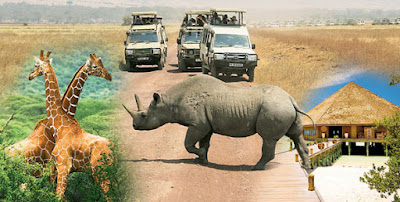
Tourism
7. Fishing: look on the presence of; water bodies such as lakes, seasonal swamps, rivers, dams, ocean. These should be surrounded by settlement.

Fishing
8. Administration
Various administrative activities can be identified from abbreviations on the map. These are given in a list in the margin of the map. They include:
a) Provision of security as evidenced by the presence of a Police Station or Police Post
b) Judicial services as evidenced by the presence of courthouse
c) Other administrative offices such as District Commissioner (DC)
d) Regional Commissioner (RC).
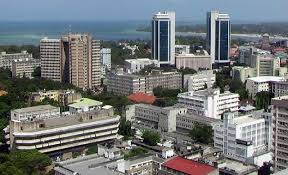
Administration
9. SETTLEMENT
A settlement comprises of a group of buildings in an area where people live and carry out social and economic activities. There are two types of settlements; rural and urban settlement.
Rural Settlements
This can be indicated by the following features:
1. Many semi-permanent and a few permanent buildings such as grass-thatched houses or ironroofed houses with mud or brick walls
2. Evidence of farming, fishing activities etc.
3. Unplanned or unevenly distributed of settlement which associated with plantations etc.

Rural Settlement
Urban Settlements
This can be identified by the following features:
1. Permanent buildings, which dominate the area
2. Regular street patterns
3. Many large buildings and warehouses indicating an industrial area
4. High numbers of people or population
5. Availability of Many motor vehicles on the road, which may lead to traffic jams
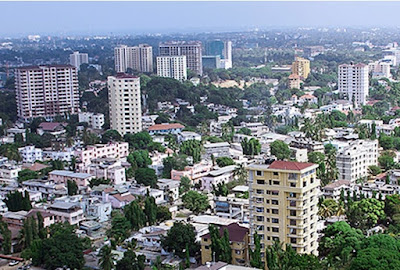
Urban Settlement
SETTLEMENT PATTERNS
It is a layout of dwellings in a particular place. The signs showing settlements on topographical maps are observed to have varied arrangement. The most common pattern include the following:
1. Dispersed Settlement Pattern: It is alternatively called scattered settlement pattern. The houses are widely spaced one to another
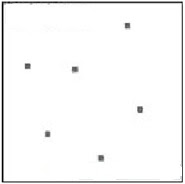
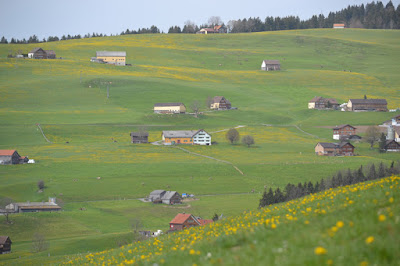
Dispersed Settlement Pattern
2. Nucleated Settlement Pattern: Houses and other related form are compacted to another.
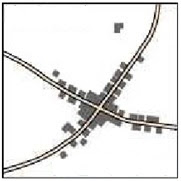

Nucleated Settlement Pattern
3. Linear Settlement Pattern: Houses are concentrated along an elongated objected of economic significance like a road, river, railway lines and others
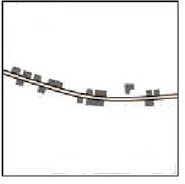

Linear Settlement Pattern
Factors Encouraging Settlements
1. A reliable source of water supply e.g. presence of permanent rivers, lakes.
2. Gentle slope i.e. people prefer to establish settlement in less hazardous areas
3. Good soil for agriculture
4. Pleasant climate condition
5. Transport and communication.
Estimating the Size of Features
Estimating the size of object in the photographed area sometimes is not easy, therefore some clues are used in order to estimate size of objects in the photographed area. Due to perspective nature of photographs, especially with regard to the ground general view photographs, it is not ease to measure and calculate possible distances from them. It is, however, possible to work out approximate sizes of objects using familiar objects in the close-up photograph such as a person, ruler or coin. This gives an impression of the relative sizes of the objects and from this we can be in a position of estimating the size of a given object in a photograph. That is why, we normally see a coin, hammer or ruler or any known object placed against rock strata to give us an idea about the size of the rock.
Parts of Photograph
A photograph has main three parts or divisions. These parts includes:
i) Foreground
ii) Middle ground
iii) Back ground
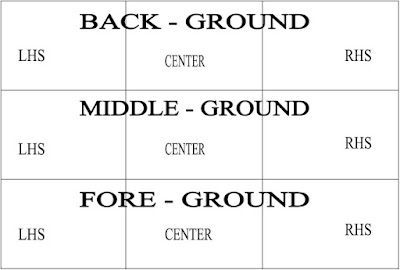
KEY
LHS = Left Hand Side
RHS = Right Hand Side
CALCULATIONS IN VERTICAL AIR PHOTOGRAPHS
Calculating the Ground Scale, Focal Length and Air-Craft Altitude
1. GROUND SCALE
Ground Scale = Focal Length / Air-Craft Altitude
NOTE: Ground Scale is usually given in ratio
Example 1
Given the Focal Length is 200mm and Air-Craft Altitude is 8000m, calculate the Ground Scale.
Ground Scale = Focal Length / Air-Craft Altitude
Ground Scale = 200mm ÷ 8000m
(change to mm, and 1m=1000m) >> 8,000,000mm
Ground Scale = 200mm ÷ 8,000,000mm
Ground Scale = 1:40,000
Example 2
Given the Air-Craft Altitude is 25,000m and Focal Length is 500mm. find the Ground Scale
Ground Scale = Focal Length / Air-Craft Altitude
Ground Scale = 500mm ÷ 25,000m (25,000,000mm)
Ground Scale = 500mm ÷ 25,000,000mm
Ground Scale = 1:50,000
2. AIR-CRAFT ALTITUDE
Air-Craft Altitude = Focal Length / Ground Scale
NOTE: Air-Craft Altitude is given either in meters or in feet
Example 1
Given the Ground Scale is 1:20,000 and Focal Length is 400mm. Calculate the Air-Craft Altitude.
Air-Craft Altitude = Focal Length / Ground Scale
Air-Craft Altitude = 400mm ÷ 1/20,000
Air-Craft Altitude = 400mm ÷ 1/20,000 >> 400mm × 20,000 /1
8,000,000mm (change to meters, and 1m=1000mm) >> 8000m
Air-Craft Altitude = 8000m
Example 2
Given the Ground Scale is 1:30,000 and Focal Length is 300mm. Calculate the Air-Craft Altitude.
Air-Craft Altitude = Focal Length / Ground Scale
Air-Craft Altitude = 300mm ÷ 1/30,000
Air-Craft Altitude = 300mm ÷ 1/30,000 >> 300mm × 30,000/1
9,000,000mm (change to meters, and 1m=1000mm) >> 9000m
Air-Craft Altitude = 9000m
3. FOCAL LENGTH
Focal Length = Ground Scale × Air-Craft Altitude
NOTE: Focal Length is usually given in millimeters
Example 1
Given the Ground Scale is 1:40,000 and Air-Craft Altitude is 8000m, calculate the Focal Length.
Focal Length = Ground Scale × Air-Craft Altitude
Focal Length = 1:40,000 × 8000m
(change to mm, and 1m=1000) >> 8,000,000 mm
Focal Length = 1/40,000× 8,000,000mm
Focal Length = 200mm

